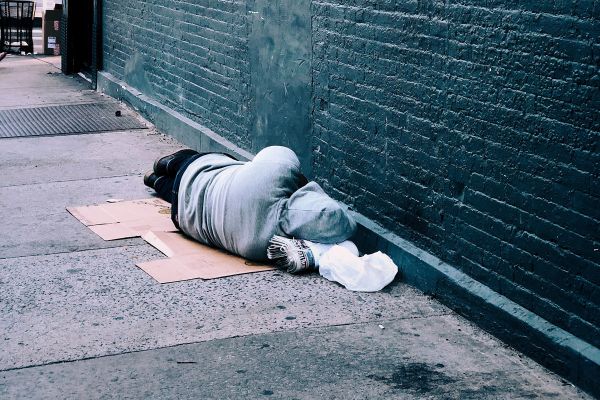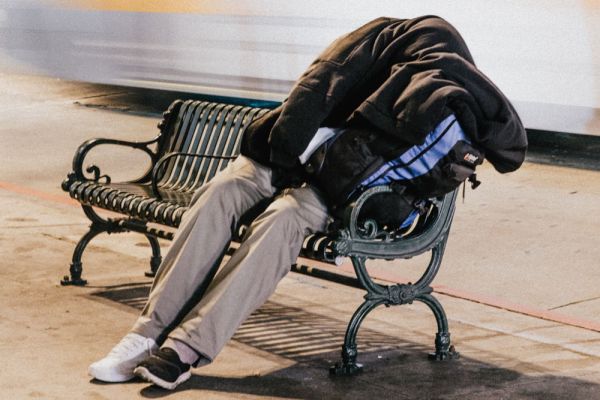 Homelessness has reached near epidemic proportions in parts of the U.S., with an estimated 580,000 people living on the streets in 2020. Living without shelter exposes us to disease, illness, assault, rape, and other forms of violence. But, more often, it also exposes us to increased instances of drug and alcohol abuse and therefore to addiction. While the popular image of the homeless addict is someone who started using and lost everything, the picture is often radically reversed, in that many homeless persons start using drugs and alcohol to cope with homelessness.
Homelessness has reached near epidemic proportions in parts of the U.S., with an estimated 580,000 people living on the streets in 2020. Living without shelter exposes us to disease, illness, assault, rape, and other forms of violence. But, more often, it also exposes us to increased instances of drug and alcohol abuse and therefore to addiction. While the popular image of the homeless addict is someone who started using and lost everything, the picture is often radically reversed, in that many homeless persons start using drugs and alcohol to cope with homelessness.
Either way, 34.7% of all homeless persons seeking aid at shelters have chronic substance use disorders. The Substance Abuse and Mental Health Services Administration only collects this data on individuals seeking aid. This means the actual number of homeless individuals with a substance use disorder is much higher. The National Coalition for the Homeless uses similar data to suggest 38% have an alcohol use disorder and 28% have a drug use disorder. That’s a massive increase from the 5% of the total adult population. Homeless persons are more at risk for drug and alcohol use and addiction. Understanding those connections can help in getting treatment, finding substance abuse treatment, and building a new life without drugs or alcohol.
Overlaps Between Risk Factors for Homelessness and Substance Use Disorder
Individuals struggling with homelessness often struggle with low income, mental illness, medical debt, and medical health problems. Combinations of mental illness, low income, and high or unexpected bills (accidents, medical care, mental healthcare) are among the most common causes of homelessness. These, in turn, are among the largest causative factors of substance use disorder. This ties into self-medication or using drugs and alcohol to cope, increased exposure to drugs and alcohol, and lack of real options regarding comfort and relaxation. Self-Medication – Homelessness causes considerable mental, physical, and emotional stress, especially for families. Homelessness challenges the self, the sense of self-worth, and one’s public image, leaving many feeling worthless, ashamed, and responsible for their lack of a home. While homelessness most often stems from bad luck with some poor decision-making, people take these burdens entirely on themselves, claim responsibility, and this is a traumatic thing. Living on the street also results in considerable stress due to exposure (cold, wind, rain), avoiding the police, jail time, exposure to violence, and exposure to drugs. People often turn to drugs and alcohol as a means of self-medicating to numb pain, reduce stress, and relax. That often includes drinking enough to fall asleep in an uncomfortable or cold and wet environment, using to relax and feel less stressed, taking stimulants to avoid sleeping in a dangerous area, etc. Mental Health Disorders – More than a quarter of all homeless persons have a mental health disorder like anxiety, depression, or PTSD. Mental health disorders greatly increase risk of substance use disorder, with an estimated 30% of individuals with mental health disorders having a substance use disorder. Economic Distress – Individuals who are homeless are often low-income, facing high debt, or facing bankruptcy. This is especially pertinent for minimum wage workers, who struggle to find housing at under 50% of their monthly wage – putting them at very high risk of homelessness. While economic distress results in homelessness, it’s also a leading cause of substance abuse and use disorder. Individuals facing or in situations of poverty are more likely to use drugs and alcohol, more likely to self-medicate with drugs and alcohol, and more likely to take large risks as a normal part of life. This occurs because of increases in stress, decreases in quality of life, and a “nothing to lose” mentality. Illness – Medical debt is a major cause of homelessness, but it also contributes to substance abuse. Individuals with recent medical problems are more likely to have access to and exposure to addictive painkillers, more likely to be in sudden traumatic or stressful situations, and more likely to be in physical pain, prompting self-medication. This exacerbates as homelessness occurs, because living on the street reduces access to shelter, clean water, fresh food, and sanitary living conditions. With lack of proper sanitation and care, everyone is significantly more susceptible to infection and illness. Essentially, there are many overlapping causes between homelessness and addiction. The same factors that result in homelessness can result in addiction, without homelessness ever occurring, and vice versa.
Does Homelessness or Addiction Come First?
 While a popularly quoted article “Substance use: Pathways to homelessness? Or a way of adapting to street life” claims that 2/3rds of homeless persons claim addiction contributed to homelessness, modern studies suggest an altogether different story. In one survey of over 4,000 homeless individuals, in which 43% struggled with substance abuse, it was found that only 15% had substance abuse problems prior to becoming homeless.
While a popularly quoted article “Substance use: Pathways to homelessness? Or a way of adapting to street life” claims that 2/3rds of homeless persons claim addiction contributed to homelessness, modern studies suggest an altogether different story. In one survey of over 4,000 homeless individuals, in which 43% struggled with substance abuse, it was found that only 15% had substance abuse problems prior to becoming homeless.
Instead, individuals listed the impacts of homelessness as contributing to their drug use, with many listing “reasons for substance abuse” like:
- Alleviating stress of living on the street
- Alleviating stress of “failure”
- Numbing traumatic experiences/emotions
- Reducing the pressure of hunger/cold
- Staying awake to decrease victimization
- Reducing physical pain from injuries/illnesses
While some people do start using and go into bankruptcy or lose a home because of that drug abuse or addiction, a large percentage go the other way.
Getting Treatment
While homeless individuals face greatly increased risks of drug abuse and addiction, they face more barriers to treatment than nearly any other group.
- Lack of a fixed address
- Lack of health insurance/Lack of financial resources
- Social stigma, preventing asking for help
- Lack of transport resources
- Lack of knowledge of options and resources
- Social isolation and separation from family or friends
This results in people staying homeless, and for longer, than if they received treatment. In one study, homeless persons with a substance use disorder stayed homeless for at least a year longer than their peers who did not use.
While barriers including money, resources, and knowledge of help are strong, getting help is still an option. Friends and family members can help a loved one move into residential care and then into a halfway or sober home, where they can recover in security. Individuals with no friends or family can often look to government programs, which differ by state, for free help – although this often does not include temporary housing. Transitional housing, including homeless shelters, housing first programs, supported living, and supportive recovery facilities can help to bridge this gap. However, getting help means taking the step to reach out, whether through a rehab center, a homeless shelter, or a mental health organization.
Homelessness provides many barriers to recovery, but there is still help. Reaching out, getting help, and using available resources is the first step to beating addiction and getting your life back.